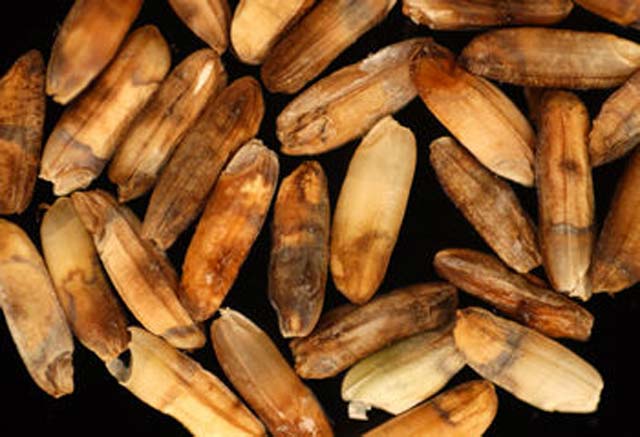Fungi
 Contamination of seed and grain with fungal organisms may result in poor germination, seedling vigor or grain quality. Storage fungi usually invade grain or seed during storage and are generally not present in large quantities before harvest in the field. The most common storage fungi are species of Aspergillus and Penicillium.
Contamination of seed and grain with fungal organisms may result in poor germination, seedling vigor or grain quality. Storage fungi usually invade grain or seed during storage and are generally not present in large quantities before harvest in the field. The most common storage fungi are species of Aspergillus and Penicillium.
These fungi are widely distributed and almost always present. Contamination occurs through small quantities of spores contaminating the grain as it is going into storage from the harvest, in handling and storage equipment or from spores already in the storage structures. Under high temperatures and moisture this small amount of inoculum can increase rapidly.
The development of fungi is influenced by the:
- Moisture content of the stored grain
- Temperature
- Condition of the grain going into storage
- Length of time the is grain stored and
- Amount of insect and mite activity in the grain.
Fungi cause two distinct problems in storage grains.
- These are grain spoilage from fungal growth or molds and
- the production of poisonous mycotoxins.
Grain spoilage causes poor germination, loss of weight, loss of nutritive value, poor milling quality and deterioration in flavor and color of the rice. While the losses from spoilage may be of greater economic significance, they are less dangerous than the presence of mycotoxins. Mycotoxins are poisonous chemical compounds produced by certain fungal species that infect crops. While these fungi are not common in rice, they have been isolated from rice.
Management Options
Safe Storage Conditions
Grain damage by fungi will be reduced when grain and seed is:
- Stored at moisture contents below 13–14%. It is important to be aware that there is variation in moisture content through a grain mass and fungi will grow where moisture is suitable and not according to the average moisture content of the grain stack
- Stored at temperatures below 20oC and above 40oC.
- Not cracked and broken kernels or contain large amount of foreign material - broken or cracked kernels are more likely to be contaminated going into storage and more likely to be invaded once they are in storage than whole kernels.
- Free from fungi coming into store. Grains moderately invaded by storage fungi develop damage at lower moisture content, at a lower temperature and in a shorter time period than grain free or almost free of storage fungi.
- Stored for a shorter period. Grain that is to be stored for only a few weeks before processing can be stored safely with a higher moisture content and more extensive invasion by storage fungi and can be kept at a higher temperature than grain that is to be stored for months or years.
- Free from insect and mites. Insects and mites can carry fungal spores on their bodies thus introducing storage fungi into the grain mass. Insect activity in a grain mass leads to an increase in both the temperature and moisture content of the grain surrounding the insect infestation. In these 'hot spots' conditions may be favorable for mold growth.
Grain treatment
Infected seeds can be treated by either physical or chemical treatments, or a combination of both methods. Seed borne bacteria can be treated by dry heat at 65oC for 6 days or dipping in hot water treatment at 52–55oC. Seeds can also be treatment with fungicides such as Dithane M-45 and Benlate at the rate of 3 grams kg-1.
The most effective method of treating mycotoxin problems is avoidance. This is possible by drying the grain to a safe moisture content before storage, reducing physical damage to the grain during harvesting and storage and ensuring clean, dry insect-proof storage conditions.
Minimize Damage
Little can be done to prevent or reduce the invasion of crops in the field by fungi. However, the following recommendations should help prevent storage fungi problems or minimize damage from storage fungi in stored grains.
- Harvest as soon as the moisture content allows for minimum grain damage.
- Adjust the harvesting equipment for minimum kernel or seed damage and maximum cleaning.
- Clean all grain harvesting and handling equipment thoroughly before beginning to harvest. Clean bins or storage facilities thoroughly to remove dirt, dust and other foreign material, crop debris, chaff and grain debris.
- Clean grain going into storage to remove lightweight and broken kernels or seeds as well as foreign material and fines.
- Moisture content is by far the most important factor affecting the growth of fungi in stored grain. After harvest, grain should be dried to safe moisture contents as quickly as possible.
- Aerate grain to safe and equalized temperatures through the grain mass.
- Protect grain from insect and mite damage.
- Check stored grain on a regular basis and aerate as needed to maintain low moisture and proper temperature.